Assessing Climate-Driven Salinity Intrusion through Water Accounting: A Case Study in Ben Tre Province for More Sustainable Water Management Plans
Abstract
1. Introduction
2. Study Area
3. Data Availability and Methodology
3.1. Data Availability
- (i)
- Ground-measure data
- (ii)
- Open-source data
- (iii)
- Other data types
3.2. Methodology
3.2.1. Overall Methods
3.2.2. Water Accounting Framework
3.2.3. Numerical Modeling Approach and Simulation Scenarios
Numerical Modeling Approach
Simulation Scenarios
4. Results and Discussion
4.1. Water Demand in Comparison with Total Surface Water Availability in 2016 and 2030
4.2. Water Management Effeciency of Water Infrastructures
4.3. Measure Assessment for Sustainable Water Management
5. Conclusions
- The province has abundant amounts of surface water resources of about 25.5 km3 and 23.3 km3 of water available in the dry season for the scenarios of the extreme drought year 2016 and the future year 2030, which is much higher than the total water demand of 5.215 km3 and 5.234 km3. However, these water resources are unevenly distributed temporally and spatially in the study area. Moreover, saline water intrusion significantly causes severe water stress in the study area, highlighting the importance of effective water management measures to mitigate the impacts of saline intrusion and ensure sustainable water resources, especially in the future under increasing climate change impacts.
- The existing water management methods are inadequate for controlling saline intrusion, leading to over 57% of areas being affected by the medium to critical water stress level. The planned solution by 2030 significantly improves water management but still leaves around 11.4% of areas affected by the medium water stress level, despite that structural measures fully enclose the study area. Our study concludes that the governments at multiple levels should invest in long-term, more sustainable measures (structural and non-structural measures) for not only Ben Tre but also other coastal provinces in a master plan in the VMD. These measures should be completed in different systems to maximize the effectiveness.
- Three measures are proposed to be incorporated into the planned irrigation system, focusing on water-saving and water demand reduction in the study area. The results showed that regions affected by water stress from medium to critical levels were reduced to 11.2%, 4.6%, and 3.2% of the total study area in the TRC TO FTC, AWD IRRIGATION, and TRC TO TWC & AWD IRRIGATION measures, respectively. Among these measures, the TRC TO TWC & AWD IRRIGATION measure is the most suitable measure to be added to the planned irrigation system towards more sustainable water management by 2030.
Author Contributions
Funding
Institutional Review Board Statement
Informed Consent Statement
Data Availability Statement
Acknowledgments
Conflicts of Interest
Appendix A
| Station Name | Parameters | Data Frequency | ||
|---|---|---|---|---|
| Hourly | Daily | Monthly | ||
| Ben Trai | Water level; Salt | 2016, 2020 | ||
| An Thuan | 2016, 2020 | |||
| Binh Dai | 2016, 2020 | |||
| My Hoa | 2016, 2020 | |||
| Cho Lach | Water level | 2016, 2020 | ||
| My Thuan | Water level; Flow | 2016, 2020 | ||
| Huong My | Salt | 2016, 2020 | 2000–2020 | |
| Dong Tam | Salt | 2016, 2020 | 2000–2020 | |
| Son Doc | Salt | 2016, 2020 | 2000–2020 | |
| An Dinh | Salt | 2016, 2020 | 2000–2020 | |
| Giao Hoa | Salt | 2016, 2020 | 2000–2020 | |
| Loc Thuan | Salt | 2016, 2020 | 2000–2020 | |
| Ba Tri | Rainfall; Air Temperature; Wind; Humidity; Sunshine | 2005–2020 | 2005–2020 | |
| Ben Tre | 2005–2020 | 2005–2020 | ||
| My Tho | 2005–2020 | 2005–2020 | ||
| Cang Long | 2005–2020 | 2005–2020 | ||
| Tra Vinh | Rainfall | 2005–2020 | ||
| Cai Lay | 2005–2020 | |||
| Go Cong Dong | 2005–2020 | |||
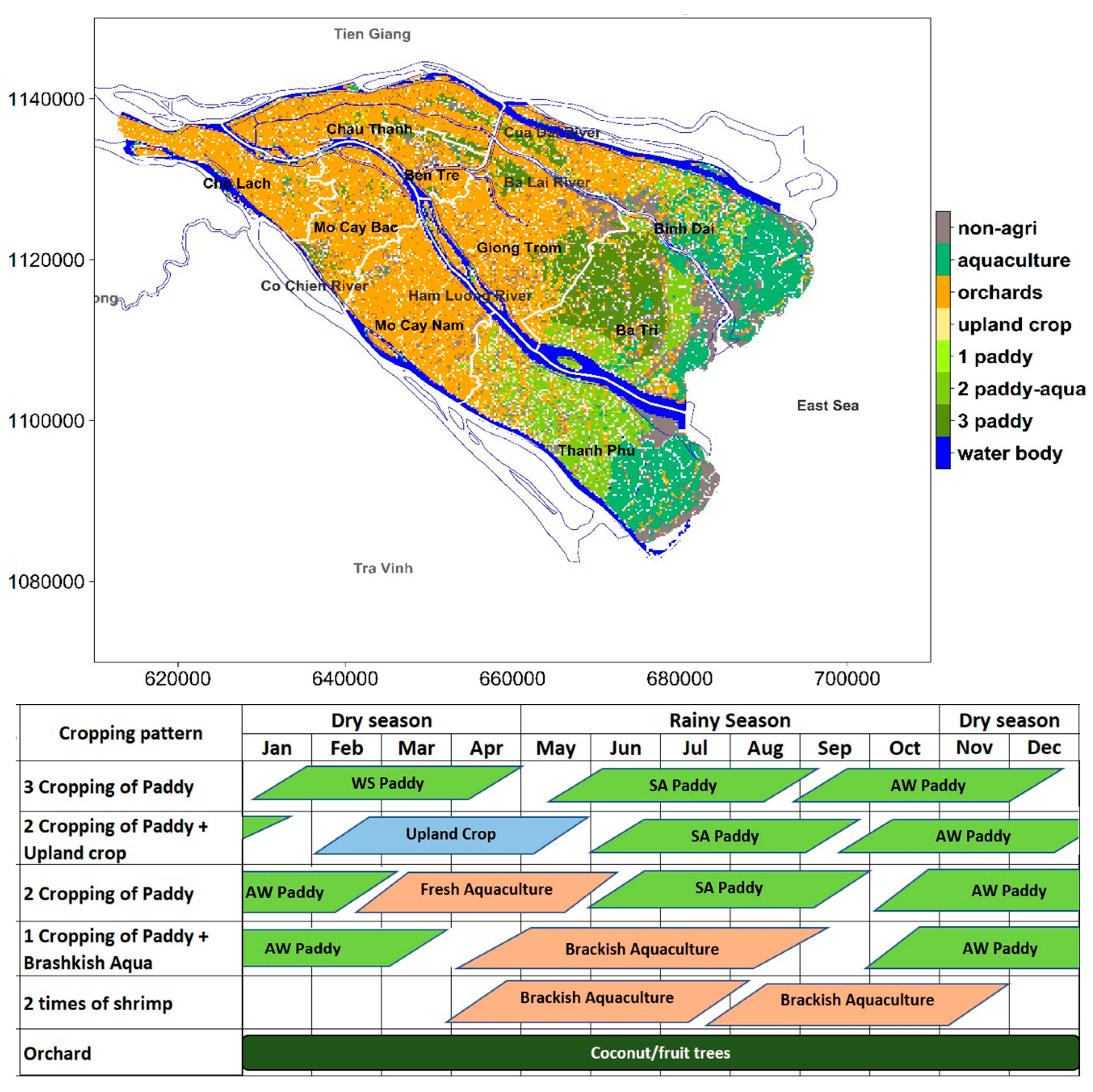
References
- Dhakal, C.; Khadka, S.; Park, C.; Escalante, C.L. Climate change adaptation and its impacts on farm income and downside risk exposure. Resour. Environ. Sustain. 2022, 10, 100082. [Google Scholar] [CrossRef]
- Nguyen, H.Q.; Tran, D.D.; Luan, P.D.M.H.; Ho, L.H.; Loan, V.T.K.; Anh Ngoc, P.T.; Quang, N.D.; Wyatt, A.; Sea, W. Socio-ecological resilience of mangrove-shrimp models under various threats exacerbated from salinity intrusion in coastal area of the Vietnamese Mekong Delta. Int. J. Sustain. Dev. World Ecol. 2020, 27, 638–651. [Google Scholar] [CrossRef]
- Tran, D.D.; Huu, L.H.; Hoang, L.P.; Pham, T.D.; Nguyen, A.H. Sustainability of rice-based livelihoods in the upper floodplains of Vietnamese Mekong Delta: Prospects and challenges. Agric. Water Manag. 2021, 243, 106495. [Google Scholar] [CrossRef]
- Tran, D.D.; van Halsema, G.; Hellegers, P.J.G.J.; Hoang, L.P.; Ludwig, F. Long-term sustainability of the Vietnamese Mekong Delta in question: An economic assessment of water management alternatives. Agric. Water Manag. 2019, 223, 105703. [Google Scholar] [CrossRef]
- Tran, D.D.; van Halsema, G.; Hellegers, P.J.; Ludwig, F.; Wyatt, A. Questioning triple rice intensification on the Vietnamese Mekong Delta floodplains: An environmental and economic analysis of current land-use trends and alternatives. J. Environ. Manag. 2018, 217, 429–441. [Google Scholar] [CrossRef]
- Giang, N.N.; Quang, C.N.; Long, D.T.; Ky, P.D.; Vu, N.D.; Tran, D.D. Statistical and Hydrological Evaluations of Water Dynamics in the Lower Sai Gon-Dong Nai River, Vietnam. Water 2022, 14, 130. [Google Scholar] [CrossRef]
- Loc, H.H.; Low Lixian, M.; Park, E.; Dung, T.D.; Shrestha, S.; Yoon, Y.-J. How the saline water intrusion has reshaped the agricultural landscape of the Vietnamese Mekong Delta, a review. Sci. Total Environ. 2021, 794, 148651. [Google Scholar] [CrossRef]
- Loc, H.H.; Van Binh, D.; Park, E.; Shrestha, S.; Dung, T.D.; Son, V.H.; Truc, N.H.T.; Mai, N.P.; Seijger, C. Intensifying saline water intrusion and drought in the Mekong Delta: From physical evidence to policy outlooks. Sci. Total Environ. 2021, 757, 143919. [Google Scholar] [CrossRef]
- Tran, D.D.; Dang, M.M.; Du Duong, B.; Sea, W.; Thang, V.T. Livelihood vulnerability and adaptability of coastal communities to extreme drought and salinity intrusion in the Vietnamese Mekong Delta. Int. J. Disaster Risk Reduct. 2021, 57, 102183. [Google Scholar] [CrossRef]
- Nguyen, Q.H.; Tran, D.D.; Dang, K.K.; Korbee, D.; Pham, L.D.M.H.; Vu, L.T.; Luu, T.T.; Ho, L.H.; Nguyen, P.T.; Ngo, T.T.T.; et al. Land-use dynamics in the Mekong delta: From national policy to livelihood sustainability. Sustain. Dev. 2020, 28, 448–467. [Google Scholar] [CrossRef]
- Ijaz, M.W.; Mahar, R.B.; Ansari, K.; Siyal, A.A. Optimization of salinity intrusion control through freshwater and tidal inlet modifications for the Indus River Estuary. Estuar. Coast. Shelf Sci. 2019, 224, 51–61. [Google Scholar] [CrossRef]
- Montagna, P.A.; Kalke, R.D.; Ritter, C. Effect of restored freshwater inflow on macrofauna and meiofauna in upper Rincon Bayou, Texas, USA. Estuaries 2002, 25, 1436–1447. [Google Scholar] [CrossRef]
- Kaushal, S.S.; Likens, G.E.; Pace, M.L.; Utz, R.M.; Haq, S.; Gorman, J.; Grese, M. Freshwater salinization syndrome on a continental scale. Proc. Natl. Acad. Sci. USA 2018, 115, E574–E583. [Google Scholar] [CrossRef] [PubMed]
- Rahman, M.M.; Penny, G.; Mondal, M.S.; Zaman, M.H.; Kryston, A.; Salehin, M.; Nahar, Q.; Islam, M.S.; Bolster, D.; Tank, J.L.; et al. Salinization in large river deltas: Drivers, impacts and socio-hydrological feedbacks. Water Secur. 2019, 6, 100024. [Google Scholar] [CrossRef]
- Noe, G.B.; Krauss, K.W.; Lockaby, B.G.; Conner, W.H.; Hupp, C.R. The effect of increasing salinity and forest mortality on soil nitrogen and phosphorus mineralization in tidal freshwater forested wetlands. Biogeochemistry 2013, 114, 225–244. [Google Scholar] [CrossRef]
- Yang, S.; Liu, J.; Lin, P.; Jiang, C. Coastal Reservoir Strategy and Its Applications. In Water Resources Planning, Development and Management; InTech: Horwich, UK, 2013. [Google Scholar]
- Sun, Y.; Tong, S.T.Y.; Fang, M.; Yang, Y.J. Exploring the effects of population growth on future land use change in the Las Vegas Wash watershed: An integrated approach of geospatial modeling and analytics. Environ. Dev. Sustain. 2013, 15, 1495–1515. [Google Scholar] [CrossRef]
- Trung, N.H.; Tri, V.P.D. 10—Possible Impacts of Seawater Intrusion and Strategies for Water Management in Coastal Areas in the Vietnamese Mekong Delta in the Context of Climate Change. In Coastal Disasters and Climate Change in Vietnam; Thao, N.D., Takagi, H., Esteban, M., Eds.; Elsevier: Oxford, UK, 2014; pp. 219–232. ISBN 978-0-12-800007-6. [Google Scholar]
- Park, E.; Loc, H.H.; Van Binh, D.; Kantoush, S. The worst 2020 saline water intrusion disaster of the past century in the Mekong Delta: Impacts, causes, and management implications. Ambio 2022, 51, 691–699. [Google Scholar] [CrossRef]
- Korbee, D.; Quan, N.H.; Hermans, L.; Long, P.H. Navigating the bureaucracy: An analysis of implementation feasibility for the Mekong Delta Plan, Vietnam. J. Environ. Plan. Manag. 2019, 62, 1545–1561. [Google Scholar] [CrossRef]
- Nguyen, L.A.; Pham, V.T.B.; Bosma, R.; Verreth, J.; Leemans, R.; De Silva, S.; Lansink, A.O. Impact of Climate Change on the Technical Efficiency of Striped Catfish, Pangasianodon hypophthalmus, Farming in the Mekong Delta, Vietnam. J. World Aquac. Soc. 2018, 49, 570–581. [Google Scholar] [CrossRef]
- Nguyen, T.P.; Luom, T.T.; Parnell, K.E. Mangrove allocation for coastal protection and livelihood improvement in Kien Giang province, Vietnam: Constraints and recommendations. Land Use Policy 2017, 63, 401–407. [Google Scholar] [CrossRef]
- Tran, T.A. Land use change driven out-migration: Evidence from three flood-prone communities in the Vietnamese Mekong Delta. Land Use Policy 2019, 88, 104157. [Google Scholar] [CrossRef]
- Nguyen, K.A.T.; Jolly, C.M.; Bui, C.N.P.T.; Le, T.T.H. Aquaculture and poverty alleviation in Ben Tre Province, Vietnam. Aquac. Econ. Manag. 2016, 20, 82–108. [Google Scholar] [CrossRef]
- Renaud, F.G.; Le, T.T.H.; Lindener, C.; Guong, V.T.; Sebesvari, Z. Resilience and shifts in agro-ecosystems facing increasing sea-level rise and salinity intrusion in Ben Tre Province, Mekong Delta. Clim. Chang. 2015, 133, 69–84. [Google Scholar] [CrossRef]
- Nguyen, M.N.; Nguyen, P.T.B.; Van, T.P.D.; Phan, V.H.; Nguyen, B.T.; Pham, V.T.; Nguyen, T.H. An understanding of water governance systems in responding to extreme droughts in the Vietnamese Mekong Delta. Int. J. Water Resour. Dev. 2021, 37, 256–277. [Google Scholar] [CrossRef]
- Berg, H.; Tam, N.T. Decreased use of pesticides for increased yields of rice and fish-options for sustainable food production in the Mekong Delta. Sci. Total Environ. 2018, 619–620, 319–327. [Google Scholar] [CrossRef]
- Kondolf, G.M.; Schmitt, R.J.P.; Carling, P.; Darby, S.; Arias, M.; Bizzi, S.; Castelletti, A.; Cochrane, T.A.; Gibson, S.; Kummu, M.; et al. Changing sediment budget of the Mekong: Cumulative threats and management strategies for a large river basin. Sci. Total Environ. 2018, 625, 114–134. [Google Scholar] [CrossRef]
- Anh, D.T.; Hoang, L.P.; Bui, M.D.; Rutschmann, P. Simulating future flows and salinity intrusion using combined one- and two-dimensional hydrodynamic modelling-the case of Hau River, Vietnamese Mekong Delta. Water 2018, 10, 897. [Google Scholar]
- Pham, L.D.M.H.; Guerra, J.D.P.; Nguyen, H.Q.; Korbee, D.; Tran, D.D.; Ho, L.H.; Do, Q.H.; Luu, T.; Gorman, T.; Hermans, L. Socio-hydrological approach for farmer adaptability to hydrological changes: A case study in salinity-controlled areas of the Vietnamese Mekong Delta. Hydrol. Sci. J. 2022, 67, 495–507. [Google Scholar] [CrossRef]
- Karila, K.; Nevalainen, O.; Krooks, A.; Karjalainen, M.; Kaasalainen, S. Monitoring Changes in Rice Cultivated Area from SAR and Optical Satellite Images in Ben Tre and Tra Vinh Provinces in Mekong Delta, Vietnam. Remote Sens. 2014, 6, 4090–4108. [Google Scholar] [CrossRef]
- Haskoning, D.H.V.R.; Wageningen, U.R.; Deltares, R. Mekong Delta Plan: Long-Term Vision and Strategy for a Safe, Prosperous and Sustainable Delta. 2013. Available online: https://data.opendevelopmentmekong.net/library_record/mekong-delta-plan-long-term-vision-and-strategy-for-a-safe-prosperous-and-sustainable-delta (accessed on 13 May 2023).
- Overview of Ben Tre|BENTREPortal. Available online: https://en.bentre.gov.vn/information/2019/02/overview-of-ben-tre (accessed on 13 May 2023).
- JICA. The Preparatory Survey for Ben Tre Water Management Project; JICA: Tokyo, Japan, 2016.
- Viet Nam Disaster Management Authority. Saltwater Intrusion and Drought Damage in the Mekong Delta in 2016. Office of the Central Steering Committee for Natural Disaster Prevention and Control; Viet Nam Disaster Management Authority: Ho Chi Minh, VietNam, 2016. [Google Scholar]
- Van Binh, D.; Kantoush, S.A.; Saber, M.; Mai, N.P.; Maskey, S.; Phong, D.T.; Sumi, T. Long-term alterations of flow regimes of the Mekong River and adaptation strategies for the Vietnamese Mekong Delta. J. Hydrol. Reg. Stud. 2020, 32, 100742. [Google Scholar] [CrossRef]
- Eslami, S.; Hoekstra, P.; Nguyen Trung, N.; Ahmed Kantoush, S.; Van Binh, D.; Duc Dung, D.; Tran Quang, T.; van der Vegt, M. Tidal amplification and salt intrusion in the Mekong Delta driven by anthropogenic sediment starvation. Sci. Rep. 2019, 9, 18746. [Google Scholar] [CrossRef] [PubMed]
- MRC. Situation Report on Dry Season Hydrological Conditions in the Lower Mekong River Basin: November 2020–May 2021; MRC Secretariat: Vientiane, Laos, 2021. [Google Scholar]
- VNS. Drought, Saltwater Dry up Mekong Delta’s Largest Reservoir. Available online: https://vietnamnews.vn/society/716046/drought-saltwater-dry-up-mekong-delta-s-largest-reservoir.html (accessed on 13 May 2023).
- General Statistics Office. Viet Nam Population Projection for the Period 2019–2069; General Statistics Office: Hanoi, Vietnam, 2020.
- Kam, S.P.; Hoanh, C.T.; Tuong, T.P.; Khiem, N.T.; Dung, L.C.; Phong, N.D.; Barr, J.; Ben, D.C. Managing Water and Land Resources under Conflicting Demands of Shrimp and Rice Production for Sustainable Livelihoods in the Mekong River Delta, Vietnam. CIAT. 2001, pp. 28–31. Available online: https://www.researchgate.net/publication/228918810_Managing_water_and_land_resources_under_conflicting_demands_of_shrimp_and_rice_production_for_sustainable_livelihoods_in_the_Mekong_River_Delta_Vietnam (accessed on 13 May 2023).
- MONRE. Groundwater in Long An, Tien Giang and Ben Tre, Viet Nam; MONRE: Cầu Giấy, Vietnam, 2016.
- Granados, O.H. Numerical Modelling as a Key Tool in the Decision-Making Process for Water Resources Management. 2010. Available online: https://www.researchgate.net/publication/278679107_Numerical_modelling_as_a_key_tool_in_the_decision-making_process_for_water_resources_management (accessed on 13 May 2023).
- FAO; WWC. Water Accounting for Water Governance and Sustainable Development: White Paper. 2018. Available online: https://www.fao.org/3/I8868EN/i8868en.pdf (accessed on 13 May 2023).
- FAO. Water Quality for Agriculture: Water Quality Evaluation; FAO: Rome, Italy, 1979. [Google Scholar]
- Droogers, P.; Simons, G.; Bastiaanssen, W.; Hoogeveen, J. Water Accounting Plus (WA+) in the Okavango River Basin. 2010. Available online: https://www.researchgate.net/publication/282002922_Water_Accounting_Plus_WA_in_the_Okavango_River_Basin (accessed on 13 May 2023).
- Dickens, C.; Smakhtin, V.; Biancalani, R.; Villholth, K.G.; Eriyagama, N.; Marinelli, M. Incorporating Environmental Flows into “Water Stress” Indicator 6.4.2; FAO (Food and Agriculture Organization of the United Nations): Rome, Italy, 2019. [Google Scholar]
- FAO. Irrigation Water Management: Irrigation Water Needs; FAO: Rome, Italy, 1986; Volume 3. [Google Scholar]
- Chapter 4—Determination of ETo|FAO. Available online: https://www.fao.org/3/x0490e/x0490e08.htm (accessed on 13 May 2023).
- Salvadore, E.; Michailovsky, C.; Coerver, B.; Bastiaanssen, W.; IHE-Delft, W.A.E. Water Accounting in Selected Asian River Basins: Pilot Study in Cambodia; FAO: Rome, Italy, 2017. [Google Scholar]
- Batchelor, C.; Hoogeveen, J.; Faurès, J.-M.; Peiser, L. Water Accounting and Auditing. A Sourcebook; FAO: Rome, Italy, 2016. [Google Scholar]
- Hunink, J.; Simons, G.; Suárez-Almiñana, S.; Solera, A.; Andreu, J.; Giuliani, M.; Zamberletti, P.; Grillakis, M.; Koutroulis, A.; Tsanis, I. A simplified water accounting procedure to assess climate change impact on water resources for agriculture across different European river basins. Water 2019, 11, 1976. [Google Scholar] [CrossRef]
- Mansour, M.M.; Ibrahim, M.G.; Fujii, M.; Nasr, M. Sustainable development goals (SDGs) associated with flash flood hazard mapping and management measures through morphometric evaluation. Geocarto Int. 2022, 37, 11116–11133. [Google Scholar] [CrossRef]
- Saqr, A.M.; Ibrahim, M.G.; Fujii, M.; Nasr, M. Sustainable Development Goals (SDGs) Associated with Groundwater Over-Exploitation Vulnerability: Geographic Information System-Based Multi-criteria Decision Analysis. Nat. Resour. Res. 2021, 30, 4255–4276. [Google Scholar] [CrossRef]
- Molden, D.; Sakthivadivel, R. Water Accounting to Assess Use and Productivity of Water. Int. J. Water Resour. Dev. 1999, 15, 55–71. [Google Scholar] [CrossRef]
- DHI. Reference Manual: A Modelling System for Rivers and Channels; DHI: Aarhus, Denmark, 2014. [Google Scholar]
- SIWRP. (2014–2021) Project on Flood Forecasting to Support the Cultivation Management in the Vietnamese Mekong Delta. Available online: https://siwrp.org.vn/news/khu-vuc-dbscl_435.html (accessed on 13 May 2023).
- SIWRP. (2016–2021) Project on Monitoring and Forecasting in the Water Quality to Support the Sluice Operation of Nam Mang Thit Irrigation System. Available online: https://siwrp.org.vn/admin/upload/BT_NMT_tuan_08_2023.pdf (accessed on 13 May 2023).
- SIWRP. (2016–2021) Project on Monitoring and Forecasting in the Water Quality to Support the Sluice Operation of O MON XA NO Irrigation System. Available online: https://siwrp.org.vn/admin/upload/BT_OMXN_tuan_08_2023.pdf (accessed on 13 May 2023).
- Duc Tran, D.; van Halsema, G.; Hellegers, P.J.G.J.; Phi Hoang, L.; Quang Tran, T.; Kummu, M.; Ludwig, F. Assessing impacts of dike construction on the flood dynamics of the Mekong Delta. Hydrol. Earth Syst. Sci. 2018, 22, 1875–1896. [Google Scholar] [CrossRef]
- Triet, N.V.K.; Dung, N.V.; Fujii, H.; Kummu, M.; Merz, B.; Apel, H. Has dyke development in the Vietnamese Mekong Delta shifted flood hazard downstream? Hydrol. Earth Syst. Sci. 2017, 21, 3991–4010. [Google Scholar] [CrossRef]
- Sebastian, L.S.; Sander, B.O.; Simelton, E.; Hoanh, C.T. The Drought and Salinity Intrusion in the Mekong River Delta of Vietnam—Assessment Report; CGIAR Research Centers: Hanoi, Vietnam, 2016. [Google Scholar]
- MONRE. Climate Change and Sea Level Rise Scenarios for Viet Nam; MONRE: Cầu Giấy, Vietnam, 2020.
- Whitehead, P.G.; Jin, L.; Bussi, G.; Voepel, H.E.; Darby, S.E.; Vasilopoulos, G.; Manley, R.; Rodda, H.; Hutton, C.; Hackney, C. Water quality modelling of the Mekong River basin: Climate change and socioeconomics drive flow and nutrient flux changes to the Mekong Delta. Sci. Total Environ. 2019, 673, 218–229. [Google Scholar] [CrossRef]
- MONRE. Climate Change and Sea Level Rise Scenarios 2020; MONRE: Hanoi, Vietnam, 2020.
- Yamaguchi, T.; Tuan, L.; Minamikawa, K.; Yokoyama, S. Alternate Wetting and Drying (AWD) Irrigation Technology Uptake in Rice Paddies of the Mekong Delta, Vietnam: Relationship between Local Conditions and the Practiced Technology. Asian Afr. Area Stud. 2016, 15, 234–256. [Google Scholar]
- Arai, H.; Hosen, Y.; Chiem, N.H.; Inubushi, K. Alternate wetting and drying enhanced the yield of a triple-cropping rice paddy of the Mekong Delta. Soil Sci. Plant Nutr. 2021, 67, 493–506. [Google Scholar] [CrossRef]
- VCCI; UNDP. Agricultural Transformation Model Adapting to Climate Change in the Mekong Delta; VCCI; UNDP: Can Tho, Vietnam, 2022; ISBN 9788527729833. [Google Scholar]
- Nguyen, P.; Rodela, R.; Bosma, R.; Bregt, A.; Ligtenberg, A. An Investigation of the Role of Social Dynamics in Conversion to Sustainable Integrated Mangrove-Shrimp Farming in Ben Tre Province, Vietnam. Singap. J. Trop. Geogr. 2018, 39, 421–437. [Google Scholar] [CrossRef]
- UN VIETNAM. Viet Nam: Drought and Saltwater Intrusion in the Mekong Delta; UN VIETNAM: Hanoi, Vietnam, 2020. [Google Scholar]
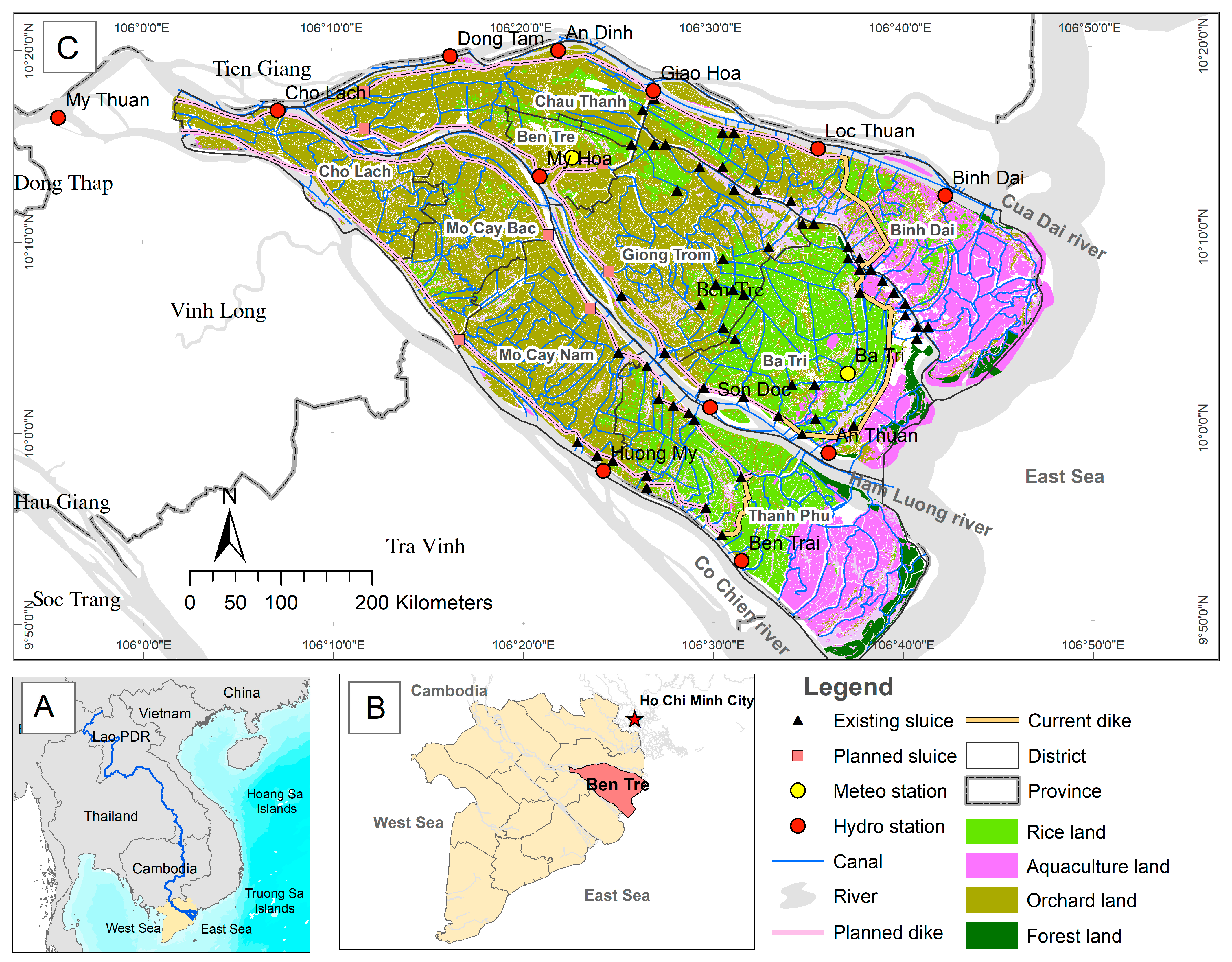
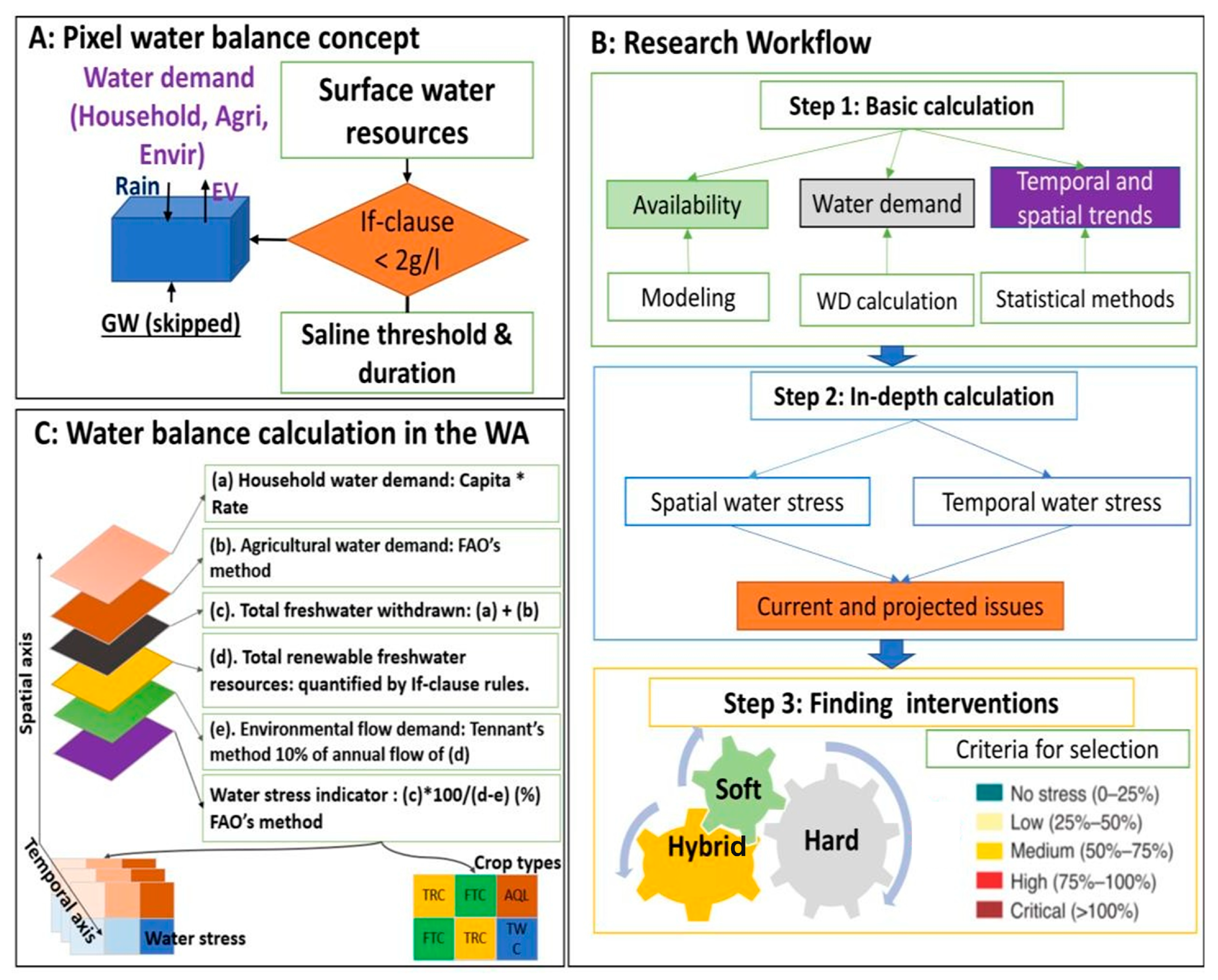
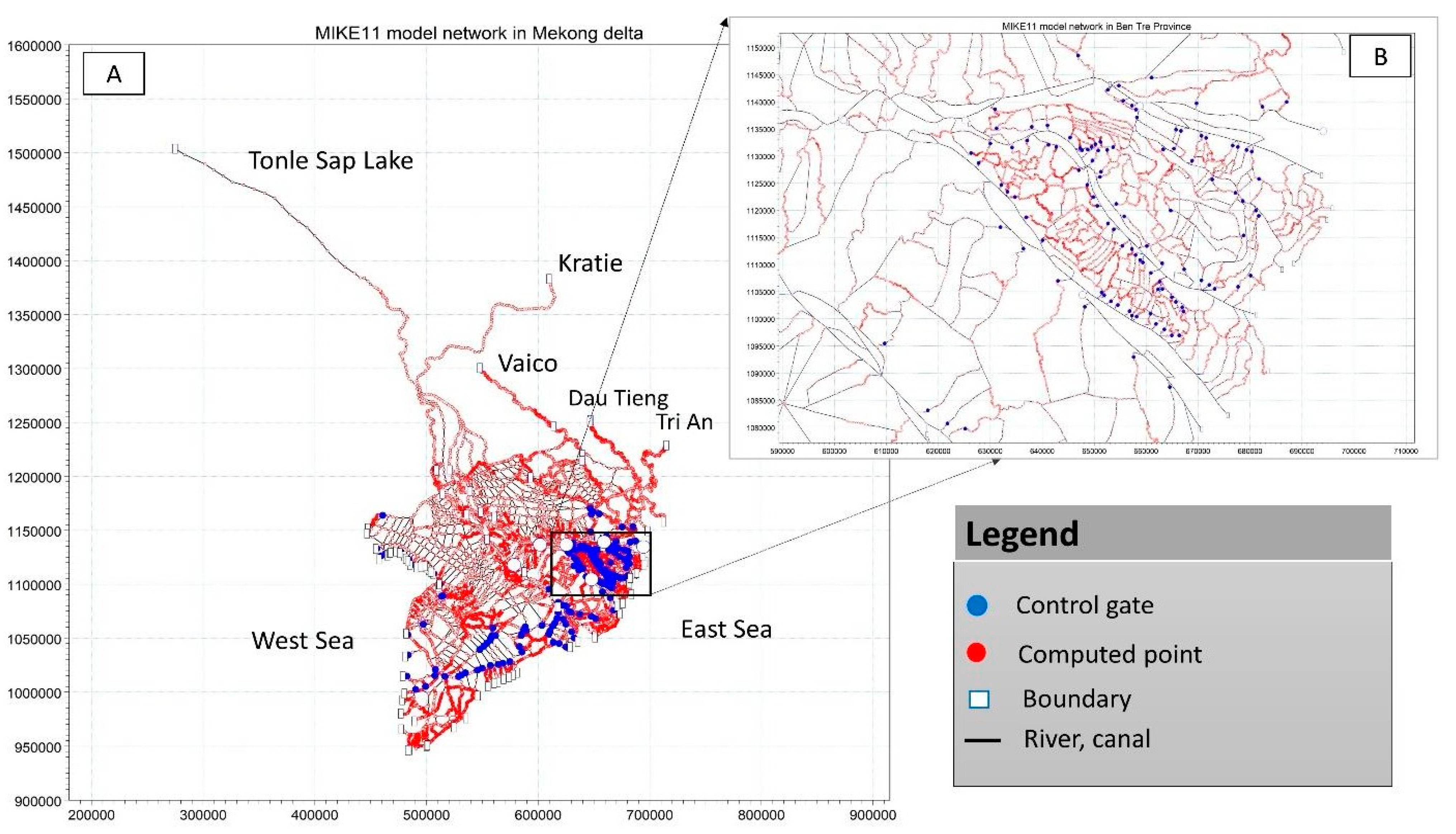

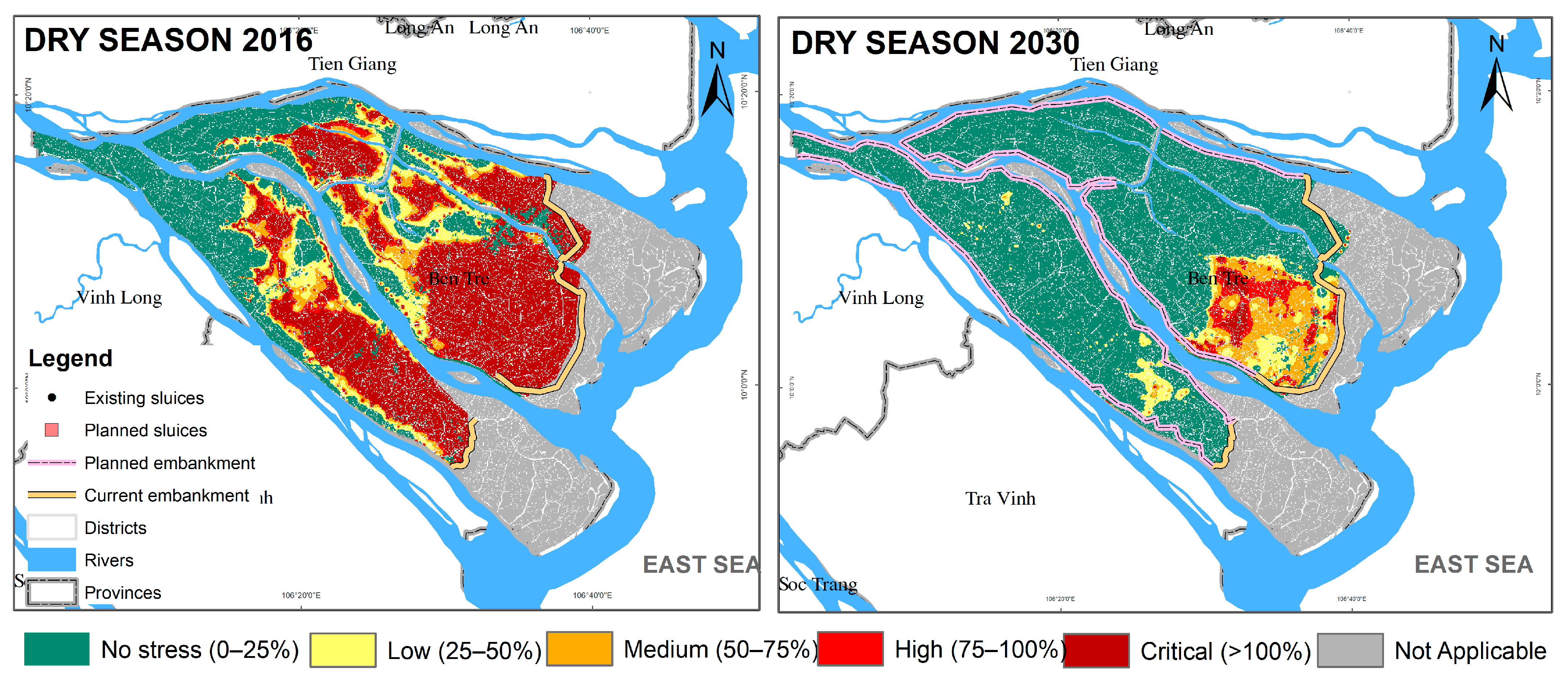
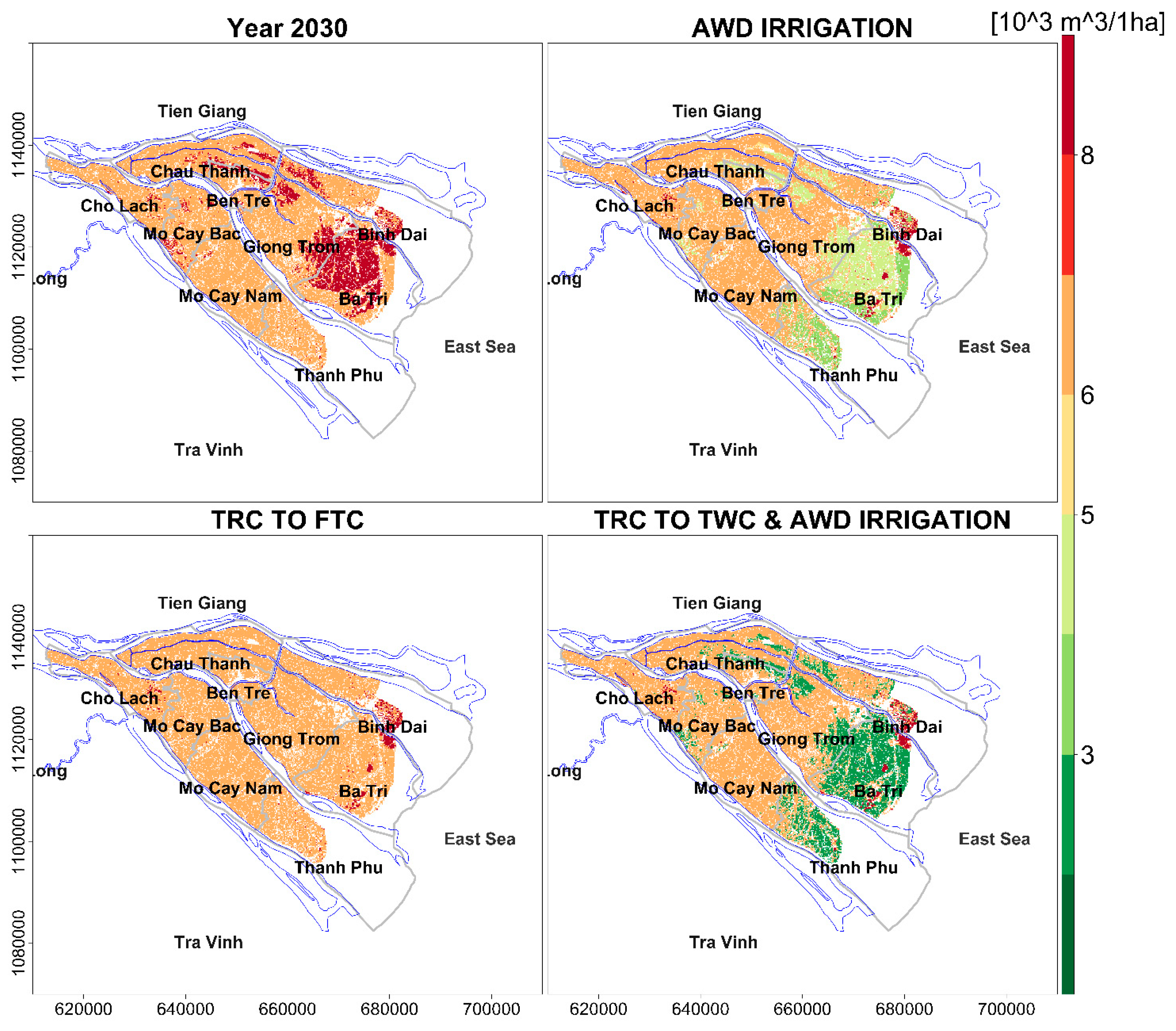

| Station | Parameter | Dry Season 2016 | Dry Season 2020 | ||
|---|---|---|---|---|---|
| NSE | R2 | NSE | R2 | ||
| My Thuan | Q | 0.95 | 0.98 | 0.93 | 0.97 |
| My Thuan | H | 0.94 | 0.98 | 0.92 | 0.97 |
| My Hoa | H | 0.97 | 0.99 | 0.96 | 0.99 |
| My Tho | H | 0.97 | 0.99 | 0.96 | 0.99 |
| Tra Vinh | H | 0.96 | 0.98 | 0.94 | 0.98 |
| Cho Lach | H | 0.96 | 0.98 | 0.94 | 0.97 |
| Scenarios | Boundary Conditions | Water Infrastructure Measure |
|---|---|---|
| Year 2016 | Upstream flow in 2016 Downstream water level in 2016 Averaged agricultural water demand 2005–2020 Household water demand in 2020 | Existing irrigation system in 2016 |
| Year 2030 | Projected upstream flow by 2030 Projected downstream water level by 2030 Averaged agricultural water demand by 2030 Household water demand by 2030 | Planned irrigation system by 2030 |
| Measures | Recommendations |
|---|---|
| AWD IRRIGATION | The traditional continuous flooded irrigation method was replaced by the Alternate Wetting and Drying (AWD) irrigation method (40% water demand cutoff) [66,67] |
| TRC TO FTC | Agricultural transformation: triple rice cropping (TRC) was replaced by fruit trees (FTC) [68] |
| TRC TO TWC&AWD IRRIGATION | Triple rice cropping (TRC) was replaced by two rice cropping and upland cropping (TWC), with AWD uses (40% water demand cutoff) |
| Month | Surface Water Resources in Y2016 | Total Water Demand in Y2016 | Surface Water Resources in Y2030 | Total Water Demand in Y2030 |
| Jan | 4.03 | 0.861 | 3.50 | 0.864 |
| Feb | 2.86 | 0.895 | 3.15 | 0.898 |
| Mar | 3.64 | 0.921 | 3.48 | 0.925 |
| Apr | 5.07 | 0.891 | 4.63 | 0.894 |
| May | 4.91 | 0.802 | 4.52 | 0.805 |
| Jun | 6.78 | 0.777 | 6.10 | 0.781 |
| Jul | 15.86 | 0.779 | 13.93 | 0.782 |
| Aug | 21.37 | 0.771 | 18.70 | 0.774 |
| Sep | 28.64 | 0.752 | 24.99 | 0.754 |
| Oct | 27.81 | 0.766 | 24.17 | 0.769 |
| Nov | 18.59 | 0.833 | 15.78 | 0.836 |
| Dec | 4.99 | 0.845 | 4.10 | 0.848 |
| Dry season | 25.50 | 5.215 (20%) * | 23.37 | 5.234 (22%) * |
| Year | 144.55 | 9.893 | 127.04 | 9.929 |
| Water Stress Category | Year 2016 | Year 2030 |
|---|---|---|
| Critical | 65,547 | 2532 |
| High | 6189 | 4259 |
| Medium | 10,024 | 9429 |
| Low | 14,329 | 7233 |
| No stress | 45,572 | 118,208 |
| Total area | 141,661 | 141,661 |
| Percent of the sum of areas from Medium to Critical levels/Total area | 57.7% | 11.4% |
| Month | Year 2030 | AWD IRRIGATION | TRC TO FTC | TRC TO TWC&AWD IRRIGATION |
|---|---|---|---|---|
| Jan | 136.88 | 122.28 | 126.28 | 103.46 |
| Feb | 171.50 | 149.05 | 157.23 | 130.63 |
| Mar | 197.51 | 169.62 | 183.61 | 152.88 |
| Apr | 167.17 | 155.29 | 181.53 | 154.27 |
| May | 78.07 | 67.97 | 69.08 | 58.07 |
| Jun | 53.75 | 43.87 | 42.97 | 36.67 |
| Jul | 54.80 | 44.73 | 50.16 | 42.27 |
| Aug | 46.46 | 41.59 | 50.77 | 42.66 |
| Sep | 26.89 | 22.81 | 22.01 | 18.13 |
| Oct | 41.93 | 33.86 | 34.09 | 28.69 |
| Nov | 109.02 | 91.64 | 103.69 | 85.54 |
| Dec | 120.40 | 104.78 | 124.37 | 103.59 |
| Dry season (Dec–May) | 871.52 | 769.00 102.52 * (13%) * | 842.10 29.42 * (3%) * | 702.89 168.62 * (24%) * |
| Year | 1204.37 | 1047.50 | 1145.78 | 956.85 |
| Water Stress Category | Year 2030 | AWD IRRIGATION | TRC TO FTC | TRC TO TWC&AWD IRRIGATION |
|---|---|---|---|---|
| Critical | 2532 | 978 | 2460 | 869 |
| High | 4259 | 1171 | 3586 | 835 |
| Medium | 9429 | 4409 | 9802 | 2864 |
| Low | 7233 | 14,626 | 7481 | 13,790 |
| No stress | 118,208 | 120,477 | 118,332 | 123,303 |
| Total area | 141,661 | 141,661 | 141,661 | 141,661 |
| Area of medium to critical levels/Total area (In percentage) | 16,220 (11.4%) | 6558 (4.6%) | 15,858 (11.2%) | 4568 (3.2%) |
Disclaimer/Publisher’s Note: The statements, opinions and data contained in all publications are solely those of the individual author(s) and contributor(s) and not of MDPI and/or the editor(s). MDPI and/or the editor(s) disclaim responsibility for any injury to people or property resulting from any ideas, methods, instructions or products referred to in the content. |
© 2023 by the authors. Licensee MDPI, Basel, Switzerland. This article is an open access article distributed under the terms and conditions of the Creative Commons Attribution (CC BY) license (https://creativecommons.org/licenses/by/4.0/).
Share and Cite
Nam, N.T.; Thuc, P.T.B.; Dao, D.A.; Thien, N.D.; Au, N.H.; Tran, D.D. Assessing Climate-Driven Salinity Intrusion through Water Accounting: A Case Study in Ben Tre Province for More Sustainable Water Management Plans. Sustainability 2023, 15, 9110. https://doi.org/10.3390/su15119110
Nam NT, Thuc PTB, Dao DA, Thien ND, Au NH, Tran DD. Assessing Climate-Driven Salinity Intrusion through Water Accounting: A Case Study in Ben Tre Province for More Sustainable Water Management Plans. Sustainability. 2023; 15(11):9110. https://doi.org/10.3390/su15119110
Chicago/Turabian StyleNam, Nguyen Trung, Pham Thi Bich Thuc, Do Anh Dao, Nguyen Duc Thien, Nguyen Hai Au, and Dung Duc Tran. 2023. "Assessing Climate-Driven Salinity Intrusion through Water Accounting: A Case Study in Ben Tre Province for More Sustainable Water Management Plans" Sustainability 15, no. 11: 9110. https://doi.org/10.3390/su15119110
APA StyleNam, N. T., Thuc, P. T. B., Dao, D. A., Thien, N. D., Au, N. H., & Tran, D. D. (2023). Assessing Climate-Driven Salinity Intrusion through Water Accounting: A Case Study in Ben Tre Province for More Sustainable Water Management Plans. Sustainability, 15(11), 9110. https://doi.org/10.3390/su15119110







